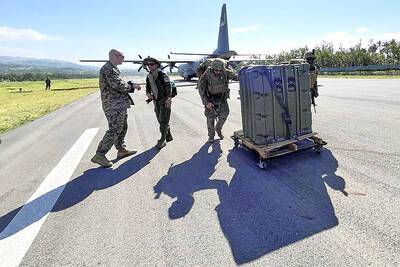The navy needs a real-time operational environment monitoring system to improve the safety of personnel and control of the battlespace, an internal navy publication argues.
The system, known in the US as the "NOWcast for operational environment and battlespace," should be developed as soon as possible since China has already launched a program to study maritime conditions surrounding Taiwan, the navy's academic monthly says in this month's edition.
Even the US has been collecting data about waters surrounding Taiwan since the 1996 Taiwan Strait Crisis, the publication says.
The data the US has collected comes from the NOWcast system. The data is not only about the water's surface but also about what is under and above the sea. The system can monitor a variety of natural elements such as wind, sea currents, solar energy and lunar illumination, waves, beach profiles and thunderstorms.
The undersea data, for example, includes range-dependent acoustic propagation profiles, sound channel positions, bottom bounce path profiles, submarine diving depth surveys and undersea terrain studies.
On the basis of the data, the US Navy can provide a three-dimensional forecast of the operational environment that its ships are to be dispatched to 48 hours in advance.
The NOWcast system was developed by the US during the Cold War. During the Cold War, the US Navy focused its attention on operational environments on the high seas. In recent years, it has focused to studying operational environments in coastal areas.
In 1996 as two battle groups of the US Navy were sent to the Strait, they found they had no knowledge about the sea environments around Taiwan.
Since then, the US navy has been collecing data on the region.
By 1984, China had already launched a full-scale study of the waters around Taiwan using spy ships of various kinds, the navy's academic monthly says.
In recent years, China has become more active in its collection of data from the Strait, going even farther into the Pacific Ocean for an understanding of the operational environments between the first and second island chains.
"The navy does not have such capabilities but has the potential to develop a local version of the NOWcast," the monthly says.
"The navy may consider joining a research program sponsored by the National Science Council. The program is called the `Taiwan Strait NOWcast Model Study.' It can be of some use to the navy," the publication says.
The research program, though not tailor-made for the navy, involves studies of sea environments which could provide vital data to the navy.
The navy is slow but not late in its development of operational environment studies, a naval official said in response to the article
"Two decades ago, the navy launched an ambitious project to establish an underwater monitoring system.
"The system was aimed at detecting submarines approaching Tawan from the east. It had scientific purposes, too," the official said.
"Six to eight kilometers' length of cable with highly sensitive acoustic sensors were laid on the sea bed off Suao. It was a difficult job. It took the navy five to six years to complete," he said.
"The project turned out to be a failure. The sensors laid on the sea bed were damaged either by strong currents or nets dropped by fishermen," the official said.
"The example shows that the navy had tried before. Although the underwater monitoring system and the NOWcast system are not the same things, they represent the same kind of efforts toward knowing in advance the coastal operational environments," the official said
The failed project was code-named "Dragon eyes," and was given top-secret status.
The project was launched in 1982 jointly by the navy and technicians from the US military.
The Chun Shan Institute of Science and Technology of the military also played a role in the project, responsible for the building of a ground receiving station for acoustic data sent from the undersea cable.

Three batches of banana sauce imported from the Philippines were intercepted at the border after they were found to contain the banned industrial dye Orange G, the Food and Drug Administration (FDA) said yesterday. From today through Sept. 2 next year, all seasoning sauces from the Philippines are to be subject to the FDA’s strictest border inspection, meaning 100 percent testing for illegal dyes before entry is allowed, it said in a statement. Orange G is an industrial coloring agent that is not permitted for food use in Taiwan or internationally, said Cheng Wei-chih (鄭維智), head of the FDA’s Northern Center for

LOOKING NORTH: The base would enhance the military’s awareness of activities in the Bashi Channel, which China Coast Guard ships have been frequenting, an expert said The Philippine Navy on Thursday last week inaugurated a forward operating base in the country’s northern most province of Batanes, which at 185km from Taiwan would be strategically important in a military conflict in the Taiwan Strait. The Philippine Daily Inquirer quoted Northern Luzon Command Commander Lieutenant General Fernyl Buca as saying that the base in Mahatao would bolster the country’s northern defenses and response capabilities. The base is also a response to the “irregular presence this month of armed” of China Coast Guard vessels frequenting the Bashi Channel in the Luzon Strait just south of Taiwan, the paper reported, citing a

A total lunar eclipse, an astronomical event often referred to as a “blood moon,” would be visible to sky watchers in Taiwan starting just before midnight on Sunday night, the Taipei Astronomical Museum said. The phenomenon is also called “blood moon” due to the reddish-orange hue it takes on as the Earth passes directly between the sun and the moon, completely blocking direct sunlight from reaching the lunar surface. The only light is refracted by the Earth’s atmosphere, and its red wavelengths are bent toward the moon, illuminating it in a dramatic crimson light. Describing the event as the most important astronomical phenomenon

UNDER PRESSURE: The report cited numerous events that have happened this year to show increased coercion from China, such as military drills and legal threats The Chinese Communist Party (CCP) aims to reinforce its “one China” principle and the idea that Taiwan belongs to the People’s Republic of China by hosting celebratory events this year for the 80th anniversary of the end of World War II, the “retrocession” of Taiwan and the establishment of the UN, the Mainland Affairs Council (MAC) said in its latest report to the Legislative Yuan. Taking advantage of the significant anniversaries, Chinese officials are attempting to assert China’s sovereignty over Taiwan through interviews with international news media and cross-strait exchange events, the report said. Beijing intends to reinforce its “one China” principle